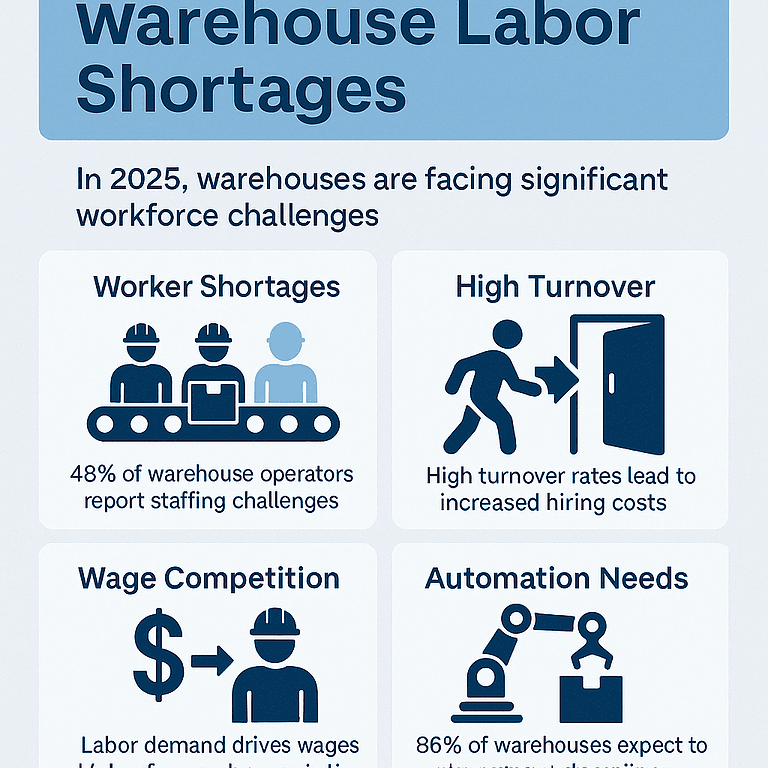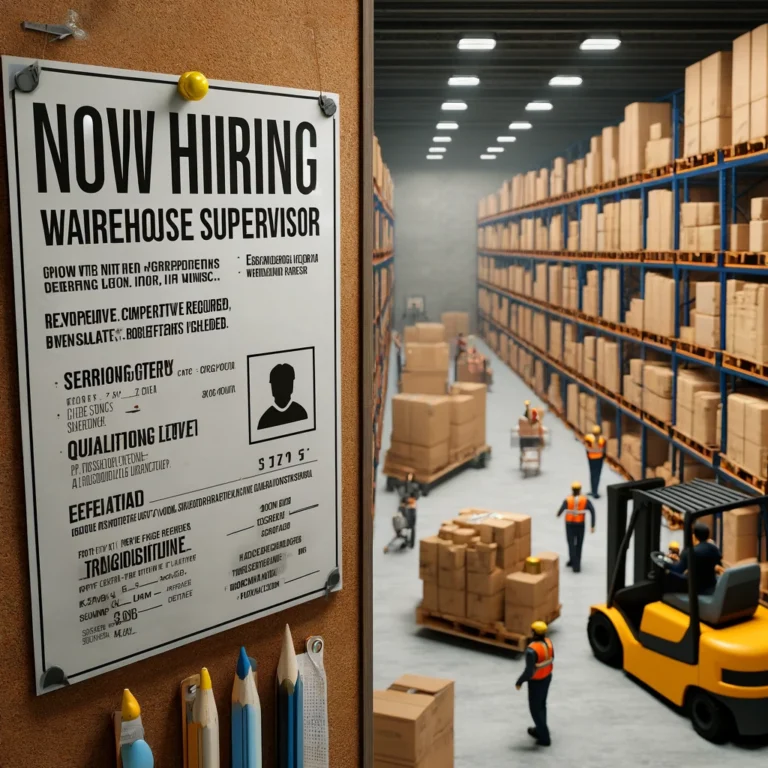Mastering Warehouse Training: Comprehensive Guide for 2025
Warehouses play a pivotal role in modern logistics and onboarding and training your staff appropriately is critical. While technology continues to provide a boost in operation efficiency, there are still vital skills needed for warehouse mastery. Please enjoy our comprehensive blog on warehouse training.

Key Takeaways
- Create a safety culture from the beginning, ensuring that new hires understand what is important to the culture.
- They understand how people learn and the tips and tricks to successfully cover all three variations in just a few training sessions.
- How can you improve your training approach, understand what works and doesn’t, and combine it for future sessions?
- Learn about the various training programs available today, including on-site workshops that offer hands-on experience, online courses that provide flexibility and self-paced learning, and formal certification programs that deliver recognized industry qualifications.
Setting the Stage for Success
Hiring new associates, especially during rapid growth, requires patience, determination, and a ‘can do’ attitude. While you may not have made the hiring decision on these folks, it’s your job to prepare them for the warehouse environment. So, covering an entire onboarding program, I will review the key areas you must discuss to be successful from day one.
Welcome!
I believe it is vitally important to have either the leader of the operation or at least someone from the senior team attend the initial training opening. I like to make sure the ‘new hires’ know who is responsible for their output and, ultimately, their success or failure within the organization.
If you want an engaging, productive culture, make sure the newbies know that right up front. Establish their purpose while they are working in your operation, and make sure to communicate your appreciation and open-door attitude (which you should have) to everyone.
Sometimes, I even use the old phrase, “If you are not happy, then I am not happy.”
Safety
The next topic I highly recommend the leader of the operation cover is safety. Again, I believe this message is critical coming from the top, and the way you communicate it, through your body language, voice tone, etc., will demonstrate whether you are serious about this topic.
Here is the approximate phrasing that I like to use:
Your safety is very important to me and this team, not only inside these walls, but everywhere you travel. It is our responsibility to ensure that you leave work in the same condition that you arrived in.
I do not want you to learn how to drive a car with your left foot or be unable to pick up that new born baby. At the end of the day, our lives matter more than anything we do in this operation.
Do NOT work unsafe. Pay close attention to the safety training you will receive over the next few days and understand that our culture is safety. We watch out for each other, we same something when we see unsafe behavior, and we ensure safety is the number one priority – your well being.
We care about you and your well-being. It’s our greatest responsibility to your family and we’re not going to let them down.
Pro Tip: The first thing I’ve learned to do when looking at new operation talent is to give the applicants a warehouse tour. I do this for two reasons. First, I want to ensure they know what they are getting into. I don’t want you to choose to be a forklift operator for the higher pay if you are afraid of heights (for example). Second, I typically walk fast between each area to see who keeps up with me. Who is engaged in what we are doing? We always remove a few candidates during this process due to their lack of interest and pace.

The Importance of Warehouse Training
Efficient training in the warehouse environment is a continual boon. It elevates productivity, streamlines order processing, and substantially enhances company profit margins.
Warehouse training sharpens essential skills such as safely handling industrial vehicles, proper material storage, and fire safety measures—all crucial to diminishing occupational hazards and fostering a safer, more efficient workspace.
Employees adept in their roles contribute to superior customer service through precise and prompt packing and shipping of goods. This proficiency plays a significant role in winning customers’ approval and satisfaction.
The Warehouse Trainer: A Multifaceted Mastermind
I would be remiss not to discuss the importance of warehouse trainers. Their performance and enthusiasm can make or break an operation.
Trainers are more than just instructors; they’re a unique blend of knowledge, personality, and adaptability. Here’s what sets them apart:
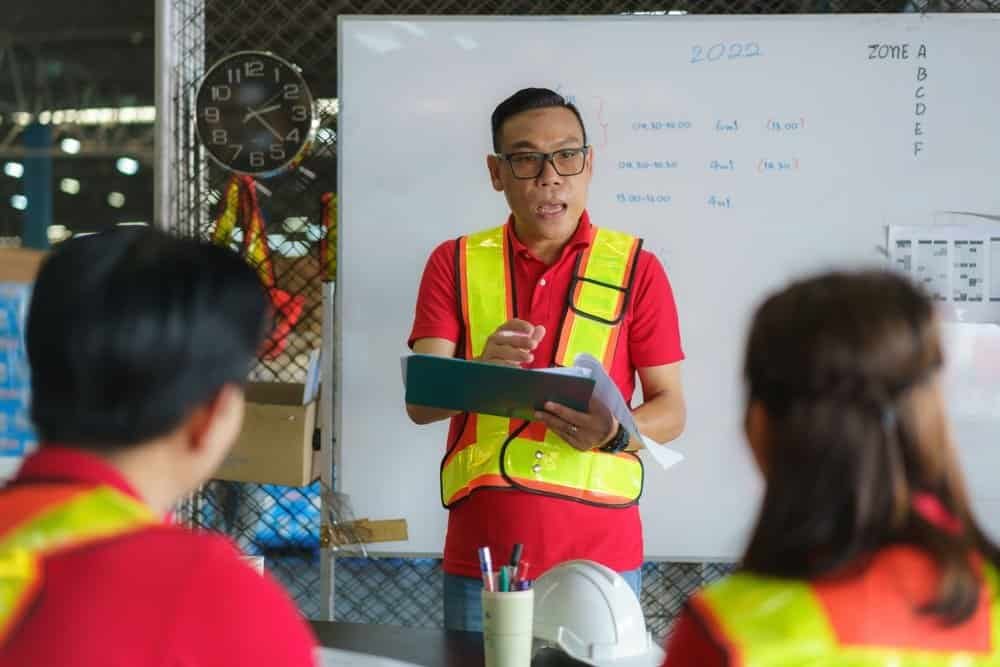
Skill Sets:
Subject Matter Expertise
A warehouse trainer must thoroughly understand operations, safety protocols, and industry best practices. This includes knowledge of equipment operation, inventory management, order fulfillment procedures, and safety regulations.
Instructional Design
Effective trainers can transform complex information into clear, easy-to-understand lessons. This involves creating engaging presentations, utilizing various training methods, and incorporating activities that cater to different learning styles.
Communication Skills
Trainers must clearly explain procedures, answer questions, and provide constructive feedback. They should also be able to adjust their communication style to resonate with diverse personalities and learning styles within the team.
Assessment & Evaluation
It is crucial to evaluate trainee comprehension and identify areas for improvement. Trainers should be adept at using assessments, quizzes, and practical evaluations to measure learning outcomes.
Motivation & Engagement
It is key to keep trainees motivated and engaged throughout the training. This might involve incorporating games, competitions, or interactive activities to make learning fun and stimulating.
Personality & Soft Skills:
Patience & Empathy
Training adults requires patience and understanding. Trainers should be able to explain concepts multiple times, offer constructive criticism, and create a supportive learning environment.
Enthusiasm & Positivity
A positive and enthusiastic attitude is contagious. Trainers who demonstrate a genuine passion for warehouse operations can inspire trainees and create a more enjoyable learning experience.
Strong Work Ethic & Organization
Trainers must be well-organized to develop effective training materials, manage their time efficiently, and adapt to unexpected situations.
Leadership & Confidence
Trainers hold a leadership role within the warehouse. They should be confident in their knowledge, command respect, and lead training sessions effectively.
Why Warehouse Trainers are Unique:
Warehouse trainers bridge the gap between theory and practice. They take complex warehouse processes and translate them into actionable knowledge for new hires or upskilling existing staff. Their ability to assess needs, design effective training programs, and motivate a diverse group of learners makes them valuable assets in any operation.

In essence, warehouse trainers are the cornerstone of a skilled and efficient workforce. Their unique blend of technical knowledge, communication skills, and engaging personality empowers them to transform individuals into proficient warehouse professionals.
Crafting Engaging Training Materials: Fueling Effective Learning
Compelling training materials are the backbone of any successful warehouse training program. They provide a clear reference point for trainees and ensure key information is readily accessible even after the training session. Here’s how to craft training materials that are clear, informative, and, most importantly, engaging:
Visual Appeal:
- Go Beyond Text: Don’t rely solely on text-heavy documents. Incorporate visuals like charts, diagrams, infographics, and high-quality pictures to break up the content and enhance understanding.
- Color & Consistency: Maintain a consistent color scheme and formatting throughout your materials for a professional and visually appealing look.
- Clear Icons & Illustrations: Utilize well-defined icons and illustrations to represent complex processes or safety protocols.
Clarity & Conciseness:
- Focus on Key Points: Avoid information overload. Prioritize the most essential information trainees need to know and present it clearly and concisely.
- Simple Language: Use clear and concise language that is easy to understand for all reading levels. Avoid technical jargon whenever possible.
- Logical Flow: Organize information logically and sequentially, building upon foundational knowledge as you introduce new concepts.
Engagement & Interaction:
- Interactive Elements: Consider incorporating interactive elements like quizzes, polls, or fill-in-the-blank sections within your handouts or presentations. While no one really likes these it does keep the participants engaged.

- Real-World Examples: Connect the training content to real-world warehouse scenarios. Use relevant examples and case studies to illustrate how the learned skills will be applied in their daily work.
- Actionable Steps: Conclude your training materials with clear, actionable steps that trainees can follow to apply the knowledge and skills they have learned on the job.
Designing Handouts & Activity Worksheets:
- Keep it Organized: Structure handouts and activity worksheets with clear headings, bullet points, and ample space for note-taking.
- Focus on Practical Application: Design activity worksheets encouraging trainees to apply the learned skills through practical exercises or case studies.
- Templates & Checklists: Consider creating reusable templates or checklists that can be easily referenced during daily operations.
Engaging training materials not only enhance knowledge retention but also make the learning process more enjoyable for trainees.
Evaluation and Continuous Improvement
Effective training doesn’t end with the delivery of the program. Evaluating trainee comprehension and incorporating feedback are crucial to ensuring your training program remains relevant and impactful. Here are some methods to evaluate your warehouse training program:
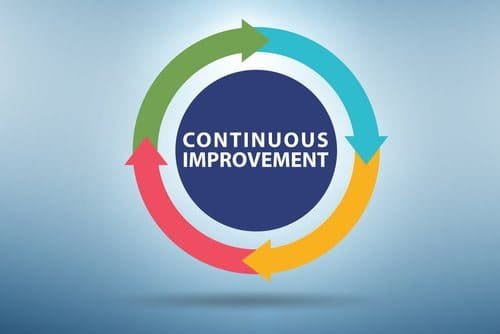
Pre- and Post-Training Assessments
Gauge Baseline Knowledge
Conduct a pre-training assessment to evaluate trainees’ existing knowledge on the topic. This helps identify areas where they might need more focus.
Measure Learning
Administer a post-training assessment to gauge trainee comprehension of the key learning objectives. This assessment can be in quizzes, practical skills demonstrations, or case studies.
Feedback Mechanisms
Surveys & Questionnaires
After the training session, distribute surveys or questionnaires to trainees. These surveys can ask about the materials’ clarity, the training methods’ effectiveness, and suggestions for improvement.
Focus Groups & Open Discussions
Conduct focus groups or open discussions with trainees to gather more detailed feedback on their experience. This allows for in-depth conversations about specific areas of the training.
Observation & Coaching
Observe trainees on the job to identify any knowledge gaps or areas where they struggle to apply the skills they have learned. If needed, provide coaching and additional support.
Analyzing Results & Refinement
Identify Areas for Improvement
Analyze the results from your assessments and feedback mechanisms. Identify areas where the training program might not meet expectations or additional support is needed.
Continuous Improvement
Refine your training program by adjusting the content, training methods, or materials based on your analysis. Strive for continuous improvement to ensure your program remains effective and addresses the evolving needs of your warehouse team.
By establishing a system for evaluation and continuous improvement, you can ensure your warehouse training program stays relevant, meets the needs of your team, and ultimately contributes to a more skilled, efficient, and safe warehouse operation.
Warehouse Training: Catering to All Learning Styles
Equipping your warehouse team with the skills they need to succeed is crucial for optimal efficiency and safety. But with diverse personalities and backgrounds on your team, a one-size-fits-all training approach might not be effective.
Understanding different learning styles can revolutionize your warehouse training program!

Learning Styles 101
People absorb information in various ways. Here are the four main learning styles:
Visual Learners
These individuals thrive on visual aids like pictures, diagrams, and videos. They learn best by seeing things demonstrated. Incorporate charts, infographics, and video demonstrations into your training sessions. Please encourage them to take notes with diagrams.
Auditory Learners
Verbal learners excel at lectures, discussions, and audio instructions. They retain information best when it is explained. Facilitate discussions, Q&A sessions, and group activities. Leverage audio recordings of key training points for review.
Kinesthetic Learners
Hands-on learners prefer practical activities, role-playing, and demonstrations. They solidify knowledge through doing. Integrate role-playing exercises, equipment simulations, and hands-on practice sessions into your training.
Reading/Writing Learners
These learners excel with written instructions, manuals, and checklists. They absorb information best through text-based materials. Provide detailed written materials, handouts, and clear step-by-step instructions. Please encourage them to summarize key takeaways in writing.
Enhancing Your Training
By incorporating various training methods that cater to different learning styles, you can create a more engaging and effective learning experience for your warehouse team. This, in turn, leads to better knowledge retention, improved skills development, and a more confident and proficient workforce.
Remember
The best training programs often use a combination of techniques. Identify the dominant learning styles in your team (through surveys or informal discussions) and tailor your training approach accordingly. By catering to individual learning preferences, you’ll empower your team to reach their full potential and ensure a successful and efficient warehouse operation.

Developing Effective Training Modules
Once you’ve identified your warehouse training needs, it’s time to translate them into clear, concise, and engaging training modules. Effective modules cater to various learning styles, ensuring knowledge is retained and readily applied in real-world warehouse scenarios.
Here are key considerations for crafting impactful training modules:
Structure & Flow:
- Start with the Basics: Begin with a clear overview of the training topic and learning objectives. Briefly explain why this skill or knowledge is important in their daily tasks.
- Logical Progression: Structure the information logically and sequentially, building upon foundational knowledge as you introduce more complex concepts.
- Variety is Key: Incorporate a mix of training methods to cater to different learning styles. This might include lectures, demonstrations, videos, group discussions, and hands-on activities.
- Conciseness is Crucial: Avoid information overload. Focus on delivering the most essential knowledge and skills to perform the task effectively.
- Conclusion & Recap: Summarize the key learning points at the end of the module. Encourage questions and address any lingering doubts or confusion.
Catering to Different Learning Styles:
Visual Learners: Incorporate charts, diagrams, infographics, and video demonstrations into your modules. Provide clear visuals to represent concepts and procedures.
- Auditory Learners: Integrate lectures, discussions, and audio recordings of key training points. Encourage active participation through group discussions and Q&A sessions.
- Kinesthetic Learners: Include role-playing exercises, equipment simulations, and hands-on practice sessions. Allow trainees to engage with the material and practice their learning skills physically.
- Reading/Writing Learners: Provide detailed written materials, handouts, and clear step-by-step instructions. Please encourage them to take notes and summarize key takeaways in writing.
Online Courses and E-Learning

E-learning courses in warehouse training are a boon to today’s digitally adept employees, providing the convenience of flexible and self-directed study options. These programs encompass a wide variety of topics, such as:
- Managing the supply chain
- Enhancing operational efficiency
- Administering inventory management
- Ensuring warehouse safety
- Overseeing logistics and transportation
These online education programs typically culminate with detailed final assessments and provide certifications, offering learners a complete and enriched learning journey.
On-Site Workshops and Seminars
Despite the ease of access provided by online courses, the unparalleled value of hands-on training through workshops and seminars conducted on-site cannot be overstated.
These sessions utilize VR technology to mimic warehouse operations, giving employees a safe space to practice and hone their skills.
Such practical experiences are instrumental in minimizing mistakes and bolstering efficiency within warehouse tasks when these trained employees apply what they’ve learned in real-world scenarios.
Certification Programs

Certification programs are the gateway to acquiring specialized skills and proficiency in managing warehouse operations. These industry-acknowledged courses offer a structured, self-paced learning path that enables individuals to gain critical knowledge about their warehousing and supply chain management roles.
Among these noteworthy certification offerings are:
- The Supply Chain Warehousing Certificate from ASCISM’s Certified Professional in Supply Management (CPSM)
- APICS is Certified in Production and Inventory Management (CPIM)
- The American Society of Transportation and Logistics Certified Logistics Professional (CLP)
- Current Good Manufacturing Practices (CGMP)
What’s the icing on the cake? Obtaining a certificate not only you with a digital badge but also your professional acclaim!
Case Studies: Successful Warehouse Training Programs
Gaining knowledge from actual events can provide decisive understanding. Case studies detailing the outcomes of effective warehouse training programs demonstrate that focused education for employees can result in:
- enhanced flexibility within the workforce
- accelerated integration of new workers, and
- improved efficiency in managing warehouse operations.
We will explore the triumphs of two firms that have revolutionized their warehouse processes by implementing robust training systems.
Company A: Implementing a Comprehensive Training Program
Company A faced an issue with inefficient and unsafe inventory handling, So It decided to tackle the problem head-on. It revamped its training program to boost employee skills while strictly enforcing safety measures.
Implementing practical workshops and instructional videos led by seasoned staff members highlighted critical practices such as correct lifting methods and consistent use of personal protective equipment.
This strategic move yielded impressive outcomes for the company’s operations—a marked improvement in efficiency paired with a reduction in on-the-job incidents. This success story underscored the significant impact of thorough training on workplace performance.
Company B: Leveraging Technology for Better Training
Company B adopted an innovative approach by integrating Virtual Reality (VR) technology into their training program for warehouse operations. Simulating the warehouse environment allowed employees to hone their skills in a safe and controlled setting.
The result was a notable decrease in the time required for employees to become fully proficient, coupled with a substantial reduction in inventory mistakes.
This serves as an encouraging illustration of the transformative impact that technology can have on training methods within warehouse settings!
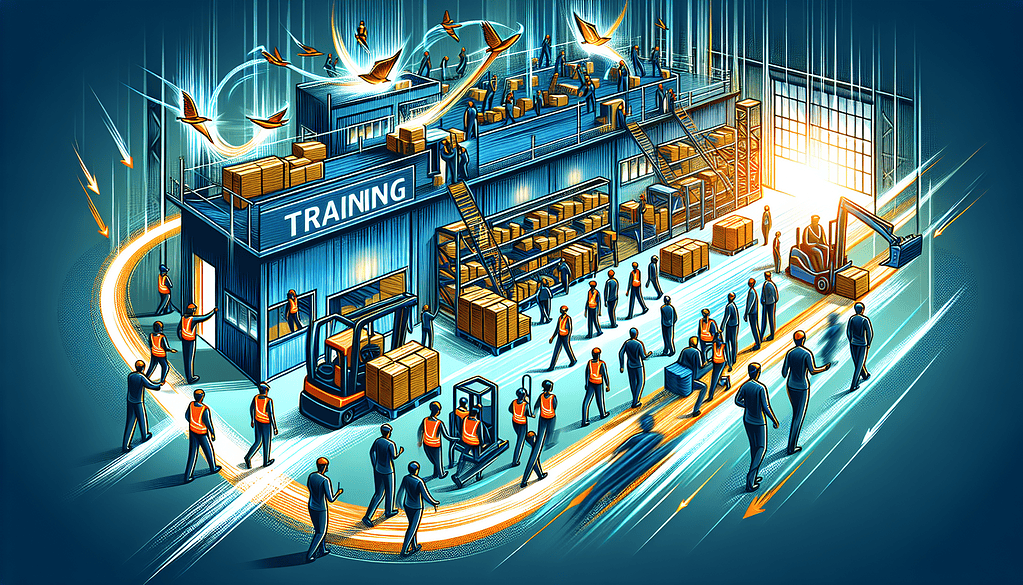
Tips for Developing a Warehouse Training Program
Crafting a training program for warehouse operations can seem overwhelming, but it’s feasible when equipped with a concise plan and practical advice. It involves pinpointing essential skills and proficiency requirements, selecting appropriate methods of instruction, and assessing the initiatives.
One can assemble an efficient educational regimen for warehouse personnel by tackling this process in stages.
Assessing Your Training Needs
Initiating a warehouse personnel training program involves determining the specific educational requirements. Everyone from entry-level staff such as clerks and operators to higher-ranking analysts, supervisors, and managers must thoroughly grasp warehousing principles and supply chain processes.
Educational courses like ‘Supply Chain Fundamentals’ are crafted for those at the introductory and supervisory tiers. It is important to recognize that an effective training initiative stems from accurately identifying these needs.
Choosing the Right Training Methods
After evaluating your training requirements, the next step is selecting appropriate training methodologies. Meticulously examine your processes and distinctive training needs.
Weigh the possibility of engaging external trainers against crafting tailored internal curriculums. While this may seem uncomfortable to the local training team, the benefits of having experts visit can be very rewarding.
Depending on what best suits your workforce’s inclinations, the resources available, and the objectives of the precise operation, you could opt for various materials such as digital content, technology applications, conventional classroom instruction, or practical, experiential techniques (my favorite method).

Measuring the Effectiveness of Your Training Program
To assess the impact of a training program, consider these strategies for gauging its success.
- Monitor performance after training to see if new skills are being applied and worker efficiency is enhanced.
- Solicit input from both participants of the program and key stakeholders involved. Do not overlook this valuable feedback.
- Implement ongoing improvement measures, including consistent evaluations and refinements to keep the program current. It’s crucial to recognize that a training initiative focuses on the tangible outcomes it produces. Hence, continually measure outcomes, extract insights from them, and use this knowledge for progressive enhancements.
Summary
To summarize, thorough training in warehouse management is essential for ensuring employees possess the skills required for successful operations.
This preparation enhances safety and productivity and addresses the increasing integration of technology and automation within warehouses.
Implementing or modernizing your training initiatives is critical to keep pace with these technological advancements. Ultimately, a proficient workforce stands at the heart of effective warehouse management.
Frequently Asked Questions
Why is warehouse training important?
Training in warehouse settings is essential, providing staff with the critical skills required for proficient warehouse managementv. This ensures that prioritizing safety and efficiency is vital for effective warehouse operations.
What are some essential skills for successful warehouse management?
Effective warehouse management hinges on robust leadership capabilities, adeptness at overseeing a varied workforce, proficient communication skills, and strong organizational talents. These competencies are indispensable for managing warehouse operations efficiently and effectively.
Problem-solving abilities and technical insight into warehouse operations significantly contribute to successful warehouse management. Managers equipped with these skills can pinpoint and tackle challenges encountered within the warehousing environment while refining processes to enhance overall operational efficiency.
What types of training programs are available?
Training programs provide a range of instruction options, including in-person sessions at the warehouse, digital classes accessible online, and instructional video content. This variety allows learners to adapt their education to fit their preferred learning style and schedule.
How is technology impacting warehouse operations?
Technological advancements are transforming warehouse operations by substituting conventional manual labor with precise, technology-fueled processes that affect all aspects of the warehouse, including inventory management and order processing.
How can I measure the effectiveness of a training program?
To evaluate the success of a training initiative, one should monitor performance after the training has concluded, examine how trainees apply new skills on the job, look for enhancements in worker productivity and efficiency, and collect opinions of the participant’s program and key stakeholders. These actions will yield critical information regarding the influence of the training program.



